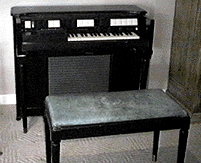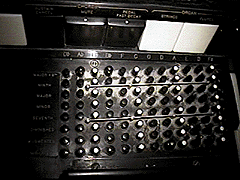 |
-- | THE
ORGAN THAT GEORGE HARRISON USED |
|---|
 |
Click on any image to see the full-size uncropped photo
 |
-- | THE
ORGAN THAT GEORGE HARRISON USED |
|---|
 |
Click on any image to see the full-size uncropped photo
While staying at a rented house on Blue Jay Way in Los Angeles in 1967, George Harrison made use of this Hammond organ and wrote a song called "Blue Jay Way," which the Beatles used in their Magical Mystery Tour film and soundtrack album.
 |
The organ remains in the house to this day. It is no longer playable - the owner reports that the last time he plugged it in, it starting smoking - but it is an interesting artifact nonetheless. With big knobs and buttons, the exterior resembles one of the original synthesizers (minus the patch cords).
The keyboard is short, less than half the usual 88 keys. That's because it's a Hammond Chord Organ. The left-hand part of the keyboard is replaced by buttons that simplify the work of making chords while the right hand plays a melody.
These organs were the "S" series, produced by the Hammond Organ Company of Chicago from the late 40's to the late 60's. This particular one is possibly an "S-6," circa 1965.
 |
From left to right, the chord buttons are arranged in circle-of-fifths order, specifically: D flat, A flat, E flat, B flat, F, C, G, D, A, E, B and F sharp (same as G flat). With this layout, the three main chords you would need for any given key (I-IV-V) are side-by-side.
The rows from top to bottom are for different variants of a chord. For example, the third row from the top is all major chords (D flat major, A flat major, E flat major, etc.) while the fourth row has minor chords (D flat minor, A flat minor, etc.).
The large black and white buttons on the face plate work kind of like organ stops, for selecting different voices and effects like percussion. There is a "Solo" section, which affects only the highest key pressed on the keyboard, and an "Organ" section, which affects all the keys pressed. Knobs adjust the relative loudness of the Solo, Organ, and Chords/Pedal sections.
 |
 |
 |
On the right-hand side of the face plate it says "Penny Owsley." This was put there by the dealer, in place of the usual "Hammond" logo. Another person who owns a similar organ told me, "This shop was L.A.'s big Hammond dealer, along with being the Steinway and Baldwin dealer for L.A."
The two foot pedals are wired to play the two most important bass notes - the root (tonic) and fifth - for whichever chord button is being pressed. Non-musicians can get a sense of what this sounds like by listening to the bass lines in traditional country music (especially Johnny Cash or Waylon Jennings), bluegrass or blues.
These organs came with a glass "pyramid" for your heel, to keep it from sliding around on the floor while bouncing from one pedal to the other. One Hammond enthusiast describes it as being "more like a coaster gone wrong... a glass disk with a slight point in the center."
It is interesting to note that although Harrison went on to use a Hammond (probably a B3 model) on the studio recording of "Blue Jay Way," by January 1969 he had come to prefer Lowry over Hammond. (Source: Get Back: The Unauthorized Chronicle of the Beatles "Let It Be" Disaster by Doug Sulpy and Ray Schweighardt, published by St. Martin's Press, New York.)
By the way, these are not black and white photos. It's the organ that's black and white.
ORGAN LINKS
The Hammond Chord Organ Page has plenty of background, including a service manual page that tells how to tune the instrument and troubleshoot burned out tubes. For more info on Hammonds in general, check Images and Information About Hammonds, New and Old. An example of a later model is on the S-100 Series Hammond Chord Organ page, which has a color scan of a page from an old Hammond catalog.
ELAweb@aol.com
(And before you ask, the answer is NO,
I do NOT know which house it is.
And if I did know I wouldn't tell YOU!)
This page established: November 16, 1997 Last updated: February 22, 2023
Organ photos taken Nov. 1997 by Saundra Renard of Desert Connection Realtors.
Special thanks to Technician@MOSweb.com and clonk@enteract.com
for additional info about Hammond organs.
© 1997-2023 Earl P. Reinhalter. All Rights Reserved.